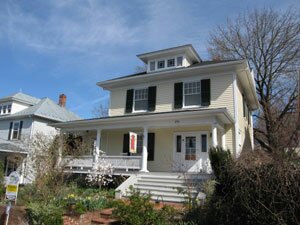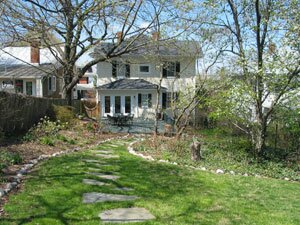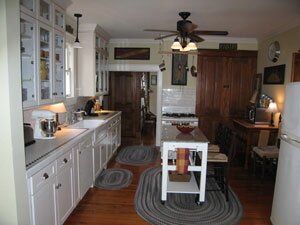REAL ESTATE- ON THE BLOCK- Tree street stunner: Faithful makeover shines in Waynesboro
ADDRESS: 376 Maple Avenue
NEIGHBORHOOD: Waynesboro
ASKING: $299,900
CITY ASSESSMENT: $251,800
YEAR BUILT: 1915
SIZE: 2,243 fin. sq. ft., 1,027 unfin.
LAND: 0.21 acres
CURB APPEAL: 8 out of 10
LISTED BY: Ellen Duerksen, Real Estate III 434-649-0928
There are renovations and then there are Renovations. This house in the "tree streets" district of Waynesboro is in the second category– Renovation with a capital R.
The owners are a young couple for whom no detail is too minute or insignificant to overlook. Case in point: in addition to restoring (by hand) all the other wood surfaces in the house– floors, built-in kitchen pantry, window and door trim, mantels– the owner hand-stripped each of the 25+ intricately carved pine stair balusters and refinished them to a rich glow. Every detail that could be addressed has been painstakingly attended to.
The project of bringing what's known as the "Kimmler House" back to its original glory has provided history lessons as well as instruction in the fine points of scavenging. As they stripped paint from the porch rails, the owners found the pencil inscription, "A.C. Kimmler," on each one, which they surmise were lumberyard notations to direct the wood to the building site. Their searches on eBay and Craigslist for materials to replace elements that had disappeared from the original house over the years took them as far afield as Massachusetts and West Virginia.
The results are apparent not only in restoration of existing original elements, but in the fidelity of changes necessary to accommodate demands of modern living. A washer and dryer were added to a half bath off the kitchen, providing plumbing that can be used for a period claw-foot tub (currently waiting in the basement) if the next owner decides to change the room to a full bath (assuming, of course, that someone would want a full bath off the kitchen). When they decided to replace attic dormer windows, they found and installed a pair from a wharf warehouse in Boston that are even earlier than the house (1830).
One of the most interesting projects was replacing the heart pine flooring in a bright breakfast area between the kitchen and the back deck/yard. Another search yielded wood from a barn that's also older than the original flooring in the house. Next to the breakfast room, a built-in pantry/storage cabinet takes up one entire wall of the kitchen. Small octagonal counter tiles match the flooring in the adjacent half bath, providing continuity as well as authenticity.
In the living room, a fireplace (originally coal-burning, so not very deep) is surrounded by shiny brown tile and topped by the original mantel with mirror. Big pocket doors separate the living room from the wide entry hall; a second door leads to the dining room with a boarded-up fireplace that probably originally hosted a wood stove. Off the dining room, a narrow sunroom provides lots of light and views of the front and back yards. An interior window looks from the sun porch to the living room, an unusual detail, but a good way to provide some light to a room with only front windows.
Upstairs, four bedrooms surround a large center landing. One of the bedrooms is actually a tiny room probably best described as an office, sewing room, or nursery– the latter an especially likely use because it's connected to the master suite. It also has a surprisingly large closet for such a small room, leading to the possibility that with the removal of some walls, the room might be converted to a dressing area or even modified completely into a much-needed second full bath.
Pull-down stairs lead to a large attic with plenty of room for storage– or expansion, with ample headroom and the aforementioned dormer windows. But using the space for storage is probably a good idea because the utility basement gets wet in heavy rains (good to know that problem isn't limited to Charlottesville houses!). The house is gas-heated by forced air. Old grates in the floors have been preserved, painted black, and add a pretty counterpoint to the beautiful heart pine. Another indication of the care spent modernizing is the fact that the central air travels through the heating ductwork, a neat trick pulled off by a skillful Waynesboro HVAC technician who's apparently a master of accommodating modern installations to old houses.
The grounds of the house are pretty if understated. Out front, above a brick retaining wall on the street, a cottage garden was in full bloom on the day we visited, and a brick path, meticulously laid in a herringbone pattern by the owners, leads to the backyard. There, the ground-level deck off the breakfast room overlooks a curving slate pathway up a slight incline to a one-car garage on the alleyway in back.
When we review houses in Waynesboro, Staunton, Madison county or other places far afield, the asking price often comes as a shock. It's almost impossible to imagine finding a house with these amenities for under $300,000 in Charlottesville at all, but to find one as painstakingly restored– with such attention to historical fidelity– is unheard of.
Yes, yes, location, location, location. Waynesboro is not Charlottesville. But it's also not Lake Monticello– or even Forest Lakes, for that matter. If speed of access is the issue, it may not be an exaggeration to say that it's quicker to get to 376 Maple Avenue on a Friday night than to get anywhere beyond the airport on 29 North.



Photos courtesy of the agent
#